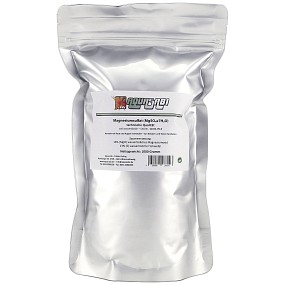The elements calcium (Ca) and magnesium (Mg), together with the other alkaline-earth metals (for example strontium and barium) build the total hardness (GH) of the water. A specific amount of magnesium (4.3556 mg/l Mg) or calcium (7.144 mg/l Ca) in water will raise the total hardness by one unit, i. e. by 1 °dGH (= one degree of total German hardness). In our water, the other alkaline earth metals are normally not present in such quantities that their contribution to the total hardness need to be taken into consideration.
With the respective water tests, you can determine the magnesium and calcium content as well as the total hardness of the water. Thanks to the relationships mentioned above, you can determine one of each of the three values by calculation, given that the other two are known.
This
calculator is helpful. First you select the element (magnesium or calcium) whose concentration you'd like to know in the menu. Then you need to enter the known total hardness (in °dGH) in the Total Hardness (GH) field and the known concentration of the other element (in milligrams per liter) in the Reference Value field. Then click the button "Calculate". The computer program now determines the concentration of the missing component and also calculates the ratio of calcium to magnesium in the water.
The ratio
Both magnesium and calcium are nutrients for aquatic plants. Magnesium, just like the important plant nutrient iron, is responsible for the formation of chlorophyll. Aquarium plants only consume little magnesium, yet it should be available in sufficient quantities (over 10 mg/l is recommended). In the aquarium hobby, ratios of calcium to magnesium of about 3:1 to 4:1 have been found to be effective. A fairly modern approach is an even lower ratio of only 2:1. Since many metal ions dissolved in the water compete to be taken up as plant nutrients, the macronutrient potassium (K) needs to be added in the calculation. It is recommended that the content of magnesium be higher than that of potassium. This is termed as the calcium-magnesium-potassium ratio, which ideally lies in the range of 2:1:0.5.
Tap water
If you're planning to use tap water for your aquarium, you should request a water analysis from your local drinking water supplier first. Most of this information can usually be found on their website, too. In addition to the total hardness, the concentrations for calcium and magnesium (in mg/l) are usually stated. With the help of the calculator you can now easily determine the Ca:Mg-ratio of your tap water. Often there is already some magnesium present, but mostly in an insufficient amount, so normally the Ca:Mg ratio is greater than 4:1. You can easily push the magnesium concentration in your aquarium water by adding Epsom salt (magnesium sulfate).

Water treatment
If you know the milligrams per liter (mg/l) content of both elements in your water, you can now adjust your Ca:Mg ratio as desired. First, let's set our ideal calcium-magnesium ratio (e. g. 3:1). Based on the determined calcium content, we calculate the required magnesium concentration using the following formula:
[calcium content in mg/l] : 3 = [target magnesium content in mg/l]
(Please note: For a 4:1 ratio, divide by 4 instead of 3. For a 2:1 ratio, divide by 2 instead of 3.)
If some magnesium is already contained in the starting water, we now subtract this amount from our target value:
[target magnesium content in mg/l] - [water magnesium content in mg/l] = [remaining difference]
The magnesium content needs to be raised by this difference. We do this by adding Epsom salt. In order to calculate the required amount of this mineral salt, we need use yet another nutrient calculator. Here we tick the calculation method "Calculate dosage for specific nutrient content" and enter our aquarium volume in liters under "Volume". In the nutrient category "Magnesium", we choose the product Epsom salt. Now enter the determined remaining difference of magnesium in the “Nutrient content” box. Click "Calculate", and the program will determine the amount of Epsom salt you'll need to add to reach your targeted Ca:Mg ratio.
Important: When you add Epsom salt, the aquarium’s total hardness will go up, too. The calculator also shows us by how much the GH will rise.
Since Epsom salt is excellently soluble in water, the dry nutritional salt can simply be added to the aquarium. To do so, just spread the portion evenly across the water surface.
Water change
Since plants only consume small amounts of magnesium, it is usually sufficient to bring the aquarium water to the desired Ca:Mg ratio once. When you perform the recommended weekly water changes, of course you'll need to enrich the fresh water with magnesium to keep the ratio intact. Calculate as described above. Just don't enter the total aquarium volume in the nutrient calculator this time but the amount of fresh water you are adding to your tank after the water change.